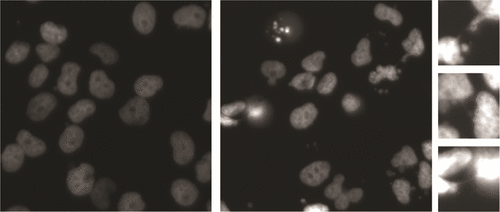当前位置:
X-MOL 学术
›
ACS Pharmacol. Transl. Sci.
›
论文详情
Our official English website, www.x-mol.net, welcomes your
feedback! (Note: you will need to create a separate account there.)
Selective Elimination of Osteosarcoma Cell Lines with Short Telomeres by Ataxia Telangiectasia and Rad3-Related Inhibitors
ACS Pharmacology & Translational Science ( IF 4.9 ) Pub Date : 2020-10-07 , DOI: 10.1021/acsptsci.0c00125 Tomas Goncalves 1, 2 , Georgia Zoumpoulidou 3 , Carlos Alvarez-Mendoza 3 , Caterina Mancusi 3 , Laura C Collopy 2 , Sandra J Strauss 4, 5 , Sibylle Mittnacht 3 , Kazunori Tomita 1, 2
ACS Pharmacology & Translational Science ( IF 4.9 ) Pub Date : 2020-10-07 , DOI: 10.1021/acsptsci.0c00125 Tomas Goncalves 1, 2 , Georgia Zoumpoulidou 3 , Carlos Alvarez-Mendoza 3 , Caterina Mancusi 3 , Laura C Collopy 2 , Sandra J Strauss 4, 5 , Sibylle Mittnacht 3 , Kazunori Tomita 1, 2
Affiliation

|
To avoid replicative senescence or telomere-induced apoptosis, cancers employ telomere maintenance mechanisms (TMMs) involving either the upregulation of telomerase or the acquisition of recombination-based alternative telomere lengthening (ALT). The choice of TMM may differentially influence cancer evolution and be exploitable in targeted therapies. Here, we examine TMMs in a panel of 17 osteosarcoma-derived cell lines, defining three separate groups according to TMM and the length of telomeres maintained. Eight were ALT-positive, including the previously uncharacterized lines, KPD and LM7. While ALT-positive lines all showed excessive telomere length, ALT-negative cell lines fell into two groups according to their telomere length: HOS-MNNG, OHSN, SJSA-1, HAL, 143b, and HOS displayed subnormally short telomere length, while MG-63, MHM, and HuO-3N1 displayed long telomeres. Hence, we further subcategorized ALT-negative TMM into long-telomere (LT) and short-telomere (ST) maintenance groups. Importantly, subnormally short telomeres were significantly associated with hypersensitivity to three different therapeutics targeting the protein kinase ataxia telangiectasia and Rad3-related (ATR) (AZD-6738/Ceralasertib, VE-822/Berzoserib, and BAY-1895344) compared to long telomeres maintained via ALT or telomerase. Within 24 h of ATR inhibition, cells with short but not long telomeres displayed chromosome bridges and underwent cell death, indicating a selective dependency on ATR for chromosome stability. Collectively, our work provides a resource to identify links between the mode of telomere maintenance and drug sensitivity in osteosarcoma and indicates that telomere length predicts ATR inhibitor sensitivity in cancer.
中文翻译:

通过共济失调毛细血管扩张症和 Rad3 相关抑制剂选择性消除具有短端粒的骨肉瘤细胞系
为了避免复制衰老或端粒诱导的细胞凋亡,癌症采用端粒维持机制 (TMM),包括端粒酶的上调或获得基于重组的替代端粒延长 (ALT)。TMM 的选择可能对癌症进化产生不同的影响,并可用于靶向治疗。在这里,我们检查了一组 17 个骨肉瘤衍生细胞系中的 TMM,根据 TMM 和维持的端粒长度定义了三个独立的组。八种是 ALT 阳性,包括以前未表征的品系、KPD 和 LM7。虽然 ALT 阳性细胞系都表现出过长的端粒长度,但 ALT 阴性细胞系根据它们的端粒长度分为两组:HOS-MNNG、OHSN、SJSA-1、HAL、143b 和 HOS 显示出低于正常的端粒长度,而 MG -63,MHM,和 HuO-3N1 显示长端粒。因此,我们进一步将 ALT 阴性 TMM 细分为长端粒 (LT) 和短端粒 (ST) 维持组。重要的是,与维持长端粒相比,亚正常短端粒与针对蛋白激酶共济失调毛细血管扩张症和 Rad3 相关 (ATR)(AZD-6738/Ceralasertib、VE-822/Berzoserib 和 BAY-1895344)的三种不同疗法的超敏反应显着相关通过 ALT 或端粒酶。在 ATR 抑制的 24 小时内,端粒短但不长的细胞显示染色体桥并经历细胞死亡,表明染色体稳定性选择性依赖于 ATR。总的来说,
更新日期:2020-12-12
中文翻译:

通过共济失调毛细血管扩张症和 Rad3 相关抑制剂选择性消除具有短端粒的骨肉瘤细胞系
为了避免复制衰老或端粒诱导的细胞凋亡,癌症采用端粒维持机制 (TMM),包括端粒酶的上调或获得基于重组的替代端粒延长 (ALT)。TMM 的选择可能对癌症进化产生不同的影响,并可用于靶向治疗。在这里,我们检查了一组 17 个骨肉瘤衍生细胞系中的 TMM,根据 TMM 和维持的端粒长度定义了三个独立的组。八种是 ALT 阳性,包括以前未表征的品系、KPD 和 LM7。虽然 ALT 阳性细胞系都表现出过长的端粒长度,但 ALT 阴性细胞系根据它们的端粒长度分为两组:HOS-MNNG、OHSN、SJSA-1、HAL、143b 和 HOS 显示出低于正常的端粒长度,而 MG -63,MHM,和 HuO-3N1 显示长端粒。因此,我们进一步将 ALT 阴性 TMM 细分为长端粒 (LT) 和短端粒 (ST) 维持组。重要的是,与维持长端粒相比,亚正常短端粒与针对蛋白激酶共济失调毛细血管扩张症和 Rad3 相关 (ATR)(AZD-6738/Ceralasertib、VE-822/Berzoserib 和 BAY-1895344)的三种不同疗法的超敏反应显着相关通过 ALT 或端粒酶。在 ATR 抑制的 24 小时内,端粒短但不长的细胞显示染色体桥并经历细胞死亡,表明染色体稳定性选择性依赖于 ATR。总的来说,











































 京公网安备 11010802027423号
京公网安备 11010802027423号